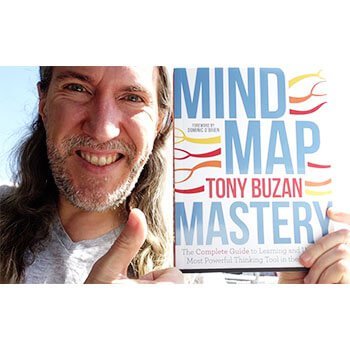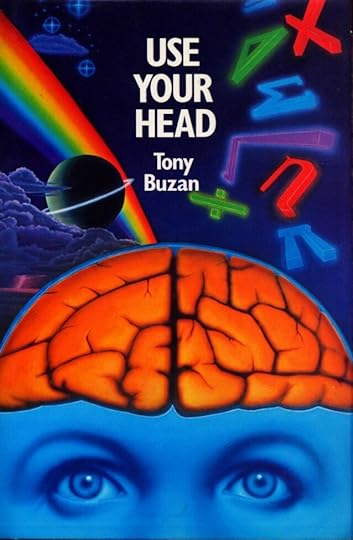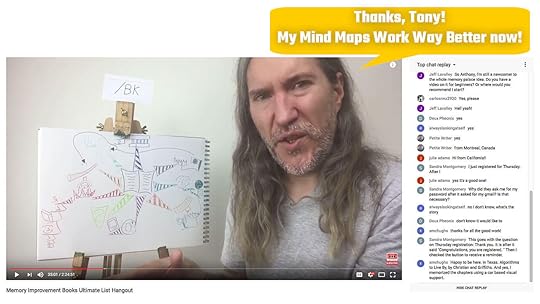Mind Map Mastery: 10 Tony Buzan Mind Mapping Laws You Should Follow
 A lot of people search the Internet for Mind Map software. And that’s great… provided they’re getting it from Tony Buzan. Most especially when you’ve read his book, Mind Map Mastery.
A lot of people search the Internet for Mind Map software. And that’s great… provided they’re getting it from Tony Buzan. Most especially when you’ve read his book, Mind Map Mastery.
Why read this book?
First of all:
No one else alive has thought so thoroughly through this incredible technique for externalizing the brain and interacting with it.
Even better, no one else has shown so thoroughly how:
A proper Mind Map boosts creativity.
How Mind Mapping as a practice improves memory.
How the process of mind mapping sets you mentally free (more on that in a bit).
It gets better too because…
No one has given more Mind Mapping examples than Tony Buzan.
And in Mind Map Mastery, Tony Buzan provides exactly what the subtitle of this book promises:
The Complete Guide To Learning And Using
The Most Powerful Thinking Tool In The Universe!
In this extensive book review, you’re about to discover:
* Why Tony Buzan’s Mind Map Mastery delivers on this promise
* Why making your thoughts visible eliminates mental exhaustion
* Why colors create mental focus and energy
* How simple limits create an infinity of ideas
* How a proper Mind Map can serve as a Memory Palace
* Bonus: How to fuse a Tony Buzan Mind Map with the Major System!
If all that sounds good to you, please read every word on this page. I promise I will earn your agreement that Mind Map Mastery by Tony Buzan is the most important book in the world!
The Future Of Mind Mapping Begins With The Past
Tony Buzan begins Mind Map Mastery with a short history.
And in case you’re wondering, yes, “history” is the right word.
Buzan has been teaching the skills of mind mapping for quite some time. Just check out this video from 1974:
This video is from the same year Use Your Head appeared. This is what one of its many book covers looked like:

As he explains in the latest book we’re discussing today (released 44 years later!), the Mind Map emerged from an understanding of the brain as a spatial arrangement of neurons.
But That Realization Didn’t Happen Overnight!
And Buzan drew upon other influences to arrive at this powerful conclusion. For example:
Buzan’s understanding of the method of loci was integrated into mind mapping.
Buzan also encountered the Major System from day one of university.
(The Major is also spatial in many ways. More on that with these 3 Powerful Memory Techniques For Memorizing Numbers.)
With the method of loci that underlies the Memory Palace technique and the Major, Tony Buzan brought the first Mind Map to life.
Yet… there was a problem!
How Tony Buzan Solved Problems With The Early Mind Map
As Buzan reflects, his first Mind Maps had problems.
In his words, they were “monochromatic, monotone and monotonous.”
Worse… he struggled to answer this question:
Is Mind Mapping Note-Taking?
In short, no. Far from it.
In essence, Buzan had revolutionized note-taking.
But for Buzan, this was not good enough. So Tony Buzan did what all great innovators do:
He showed the technique to others, particularly learners left behind by the system.
Next, Buzan observed how these learned used his early mind maps to improve their lives.
Finally, Buzan took his observations back to the Mind Mapping process so he could improve the technique.
How Tony Buzan Mind Maps Mimic The Organic
Brain Better Than Any Software
As we know from many great geniuses, solvitur ambulando.
That phrase means, “it is solved by walking.” Here’s how I memorized that term:
And solve the problems with mind mapping by walking is exactly what Tony Buzan did:
To help himself understand more about why his early Mind Maps were helping people, he walked in nature.
As a result, thoughts about how to better “mirror” the cellular nature of the brain on paper emerged.
Radiant Thinking
Observing the Mind Maps combined with walking and reflecting led to revelations about “Radiant Thinking.”
By giving people a means of connecting thoughts on paper like the brain connects ideas through cells, Mind Mapping broke free from note-taking.
Like the brain when it is operating at its full power, “Radiant Thinking” through Mind Mapping is:
Multi-faceted
Colorful
Associative
Multidimensional
Verbal and Pictorial
Imaginative and Analytical
Isn’t that exciting! Imagine being able to think in these ways all at the same time without the costs of multi-tasking!
The good news is this:
You can!
Tony Buzan Use Your Head Secrets Mixed With The Laws Of Mind Mapping
For all of these accomplishments, there was still a problem…
No matter how clear the instructions…
Some people are teaching Mind Mapping without understanding the method.
Instead of following the Laws of Mind Mapping, they are calling other techniques like these mind maps:
Spider Diagrams
Pyramid Diagrams
Concept Maps
Fishbone Diagrams
Sunburst Charts
To be clear:
None Of These Techniques Count As Mind Maps!
Look, there’s nothing wrong with using such visualizations, but to call them Mind Maps can never mirror the human brain cell.
Think about it:
What does a spider have to do with mind mapping? With human thought? With human memory?
Spiders are fantastic, but if we know one thing about human memory and learning going back to Ad Herrenium, it’s that metaphors matter.
For that, I’m glad Tony Buzan wrote Mind Map Mastery to help correct the record.
He reminds us of the Laws of Mind Mapping. He refocuses our attention on why they mirror the neuron, the central location of thought.
The Natural Reason Why Mind Maps Must Have A Central Image
Like a brain cell, a Mind Map must have a center. Without a central image, your Mind Map has no focus.
Without color, the Mind Map lacks power. Imagine going on a walk through nature in black and white.
A Fishbone Diagram built from straight-lines has nothing to do with the curves of human thought.
Concept Maps are usually overloaded with words (I am often guilty of this). As a result, they quickly become unwieldy, awkward and collapse.
Without care for balance and distribution, a Pyramid Diagram places your focus on concentrated areas. These do not help your brain create new solutions or remember more.
Would You Like An Abundance Of Mind Mapping Examples?
Tony Buzan demonstrates the validity of his claims with nearly two dozen examples.
The images in Mind Map Mastery are just as they should be:
Clear
Balanced
Colorful
Keyword focused
Evocative
Understandable at a glance
Compelling
Easy to emulate as you create your own
How Mind Map Mastery Helped Me Improve My Practice
To be honest, I’m like a lot of learners.
I get a few tips and put them haphazardly into play.
This is NOT a problem.
If anything, it is a blessing.
But no serious, mature learner can stop there.
You’ve got to return to the well of knowledge and refine your practice.
Here’s a Mind Map example from 2015 shortly after I met Tony Buzan at a ThinkBuzan training.

Then I recorded a chat with Phil Chambers about how to combine Mind Maps with Memory Palaces.
So, what’s the problem here?
After all, I used this Mind Map to:
* Write a book
* Turn the book into a video course
* Launch the course successfully with Jonathan Levi.
(This Mind Map is the first brainstorm of what became Conquering Content in Branding You Academy.)
Yet, for all that success, there are quite a few problems.
The Whole Mind Map Is Overloaded (For One Thing)
Yes, there are colors, but…
I had attended the ThinkBuzan training to learn about memory.
We did a bit of Mind Mapping, but I was so focused on the memory aspect (and not embarrassing myself) that not all the lessons got through.
And I’m just one of those learners who need to go back to the well and refine my practice through repeat exposure. For this reason, I still reread one book per month.
But… I had yet to go back to THE ultimate book on mind mapping I’d read as a kid. This lapse happened mainly because I was revisiting Buzan’s books on memory.
And I hadn’t quite learned enough Chinese to read him in Mandarin, even if he was suddenly following me everywhere!

My lack of attention to the Laws of Mind Mapping was tragic. It meant that I wasn’t getting nearly the results that I could have been.
So even though my mind mapping was successful, it was still dampened.
Then came the incredible announcement of Mind Map Mastery. I ordered it immediately.
The wait inspired me to revisit Mind Mapping in earnest.
Perhaps pretentiously, I released this video:
But what I’m talking about wasn’t advanced at all!
Though there is one virtue evident in every word I speak in the video.
Here’s why:
I was advancing my skills and practice by taking it one S.I.P. at a time (study, implement, practice).
Then, when Mind Map Mastery finally arrived, I started reading it.
I applied what it said, and before you know it, my Mind Maps improved!
Here’s a Mind Map example from one of the best YouTube Livestreams I’ve ever held:

(If you want to watch this replay and join future live streams, here’s the memory improvement books ultimate list hangout replay for you. Click subscribe and choose to be notified so you can join us next time we go live.)
What Made This Mind Map Better Than Any I’d Created Before?
The answer is simple. I just followed…
How to Mind Map Using The 10 Laws Of Mind Mapping
One: Blank paper in the landscape orientation.
Why is blank paper so important?
I believe it’s because the chemical makeup of the brain is more closely related to paper than, say, computer.
Also, the inner landscape of the mind is unlined. If you use lined paper, you are placing a barrier between your thoughts and the laws of mind mapping.
Landscape orientation is critical too because we see the world horizontally more than vertically. Peripheral vision is freer left-right than it is up and down.
I also believe landscape orientation allows for greater mirroring of another essential structure:
The clock. It is the clock formation that lets us instantly turn any Mind Map into a Memory Palace at a glance.
Two: Draw a central image in the center.

Tony Buzan says that the central image should feature at least three colors.
It’s a subtle point and one that I’ve missed many times. I look forward to putting it into practice many times in the future and observing the improvements.
The image should express your core concern with the Mind Map.
Three: Different images should appear throughout the Mind Map.
You should also use dimensions, such as drawing some of your keywords in 3D.
Four: Keywords should be capitalized.
For some reason, this is one of the toughest laws for me to follow. Maybe I read too much e..e. cummings when I was in high school.



